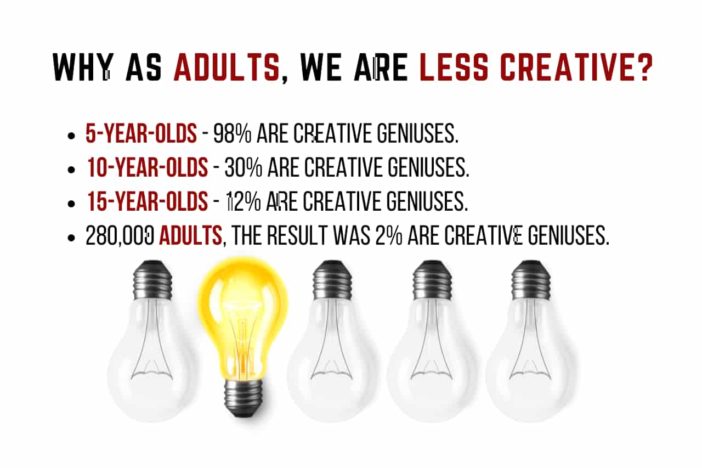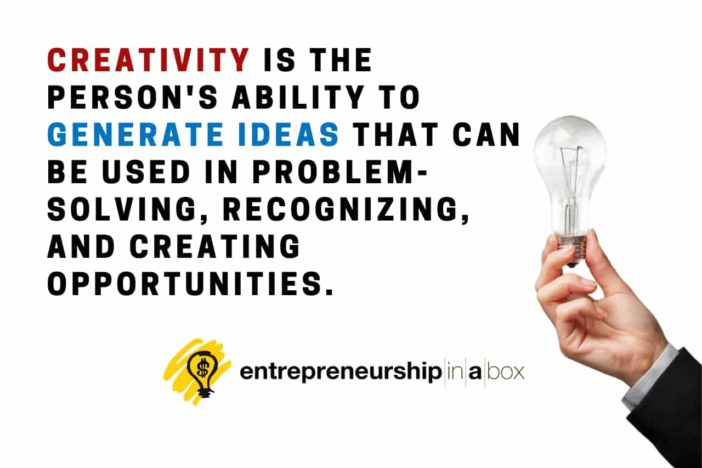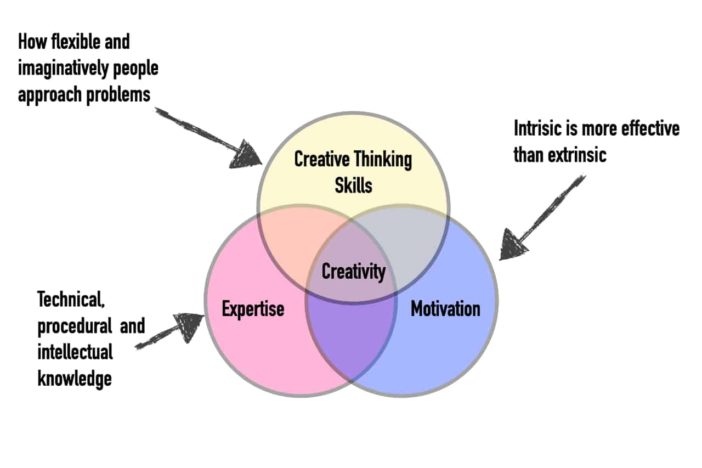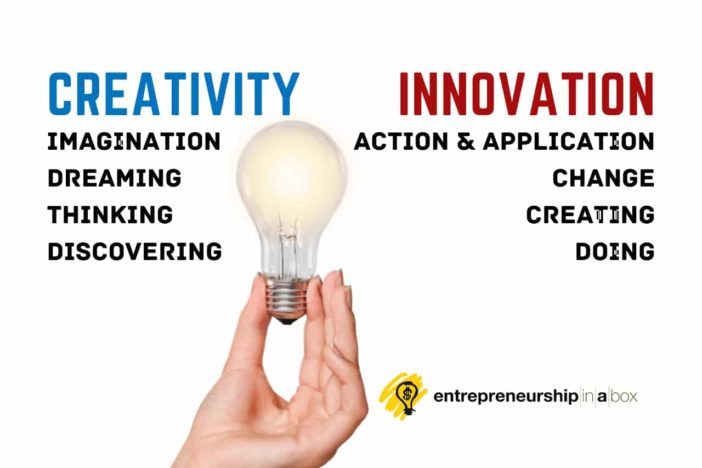How to Increase Creativity to Bring More Innovation to the Market

The fact is that every woman or man, old or young, has within them a natural innate and permanent side of their being that is so much creative. All you need to do is learn how to control and capitalize on what you already have inborn. All women, men, children in the world are born with so much creativity that they don’t use in their everyday lives.
If you go back in time and think of yourself when you were a child, you were unstoppable for many things you get in your mind. At that time, you were a creative person. You were an adventurous and opportunity-seeking person that always wanted to try and experience different things. Experiments were your everyday life. Simply, the world was infinite in its possibilities and opportunities.
Then something strange happened. Simply the system took over your own creativity. The behavior-based on doing the “right thing” is correct in all aspects of your life and has op-posed and neutralized your creative capabilities. Your parents, environment, school, or whatever other reason simply had destroyed the fantastic and endless creativity inside you when you were born.
NASA experiment for creativity
In 1968, George Land, an author, speaker, consultant, and general systems scientist, conducted research to test the creativity of 1600 children with ages from 3 to 5 years. He used the same test related to creativity that he developed for NASA. The purpose of the test was to help NASA select innovative scientists and engineers. After the first test of children between 3 and 5 years old, he has done additional on the same children at ten years of age and again at 15. The results were astounding.
- Amongst 5-year-olds, the result was 98% are creative geniuses.
- Also, amongst 10-year-olds, the result was 30% are creative geniuses.
- Amongst 15-year-olds, the result was 12% are creative geniuses.
- When the same test is done on 280,000 adults, the result was 2% are creative geniuses.

According to the results, we can see that we are more creative as young kids because we are looking through eyes without the impact of other social elements. When we become teenagers and adults, we start to change everything we see. Simply, we used filtered thinking because of the impact of outside factors. To convert this filtered thinking, we need to begin combining our different experiences and synthesize new ideas. Kids are more creative because they look at the world with totally fresh eyes. They are constantly collecting information, data, and facts. For them, everything is a new experience. However, once they start formal education and socializing with other children, they are forced to fit in the current acceptable framework that simply kills creativity.
What is creativity?
Creativity is everywhere around you. If you think that creativity is just for your business, or it’s in high demand for wars, or when you play the game, you are wrong. Those are only some simple areas that you can be creative. But, having in mind that you base your life on everyday problem-solving processes, we can say that you need to be creative everywhere.
So, the question is, what is creativity?
Simply, you are a creative person if you succeed in making something from nothing. In the case of entrepreneurs, you as an entrepreneur create something that is your business from nothing. You create products and services unavailable on the market or business models different from what already exists on the market. Also, you are a creative entrepreneur when you design distribution channels that even don’t exist previously. So, all of these things are creating something from nothing.
Creativity is the person’s ability to generate ideas that can be used in problem-solving, recognizing, and creating opportunities. It is simply connecting the dots. For Steve Jobs, creativity is all about connecting the dots, or how he was told it is “just connecting things.”

How to improve your creativity?
To start increasing your creativity, you will need to start with changing three things:
- You need to start with positive thinking on as much as possible things around you. Change the statement “there is no chance” in “everything is possible.”
- Start building your self-confidence and change your fear of mistakes in encouragement to try something new.
- Become curious as much as possible. Change the sense of insecurity before others to ask “why” or “why not.”
Can you learn to become a more creative person?
The next important question is, can creativity be taught or learned somehow?
Yes, creativity skills can be learned. Not from reading and sitting at the school desk, but by learning, experimenting, and applying creative thinking processes. Scott, Leritz, and Mumford from the University of Oklahoma, in their study: “The Effectiveness of Creativity Training: A Quantitative Review,” found that great training programs for creativity training programs can be beneficial for increasing creativity. They also found that better creativity development programs use realistic exercises and focus on cognitive skills and heuristic skill application.
3 Important Elements of Your Personal Creativity
But, the question is, what are the elements of your personal creativity. There are three components of creativity, according to Teresa Amabile, Harvard Business School professor:
1. Expertise
Expertise includes everything that you as an individual known as technical, procedural, and intellectual knowledge. For example, suppose you want to work on new innovative drugs for some specific diseases. In that case, your expertise will need to include scientific thinking, knowledge, and technical abilities in the fields of medicine, chemistry, biology, and biochemistry acquired through formal education, practical experience, or interaction with other professionals.
2. Creative thinking skills
The creative thinking skills you have are the second important part of your creativity. They refer to how you approach problems and solutions and your capacity to put existing ideas together in new combinations. This is how flexible and creative people approach the problem-solving process. Creative thinking skills depend on your personality as well as on how you think and do your work. Let’s come back to the previous example in the development of new drugs. You will be more creative if you are comfortable disagreeing with others or challenging the current status quo situation.
Challenging the current status quo is one of the most significant sources of creativity. The world will not be like we know today if many creative scientists have not approached challenging status quo situations.
For example, Archimedes and his famous “Eureka” moment represent magic creative moments that come from nowhere. But even it may sometimes feel that ideas just come into our brains out of nothing, there is much more involved in the process. He was asked by King Hiero First of Syracuse to check if all the gold had really been used by the goldsmiths in the crown. The commitment to solve the problem was the first thing here. The second thing was reviewing everything known until then to find that there is still no way to measure the density of an irregular-shaped object. The creative moment comes after creative frustration without solving the problem when Archimedes decides to relax and go to the bath.
What will our science achieve if Copernicus and Galileo don’t ask themselves what if the earth is not the center of the Universe? Or, if Isaac Newton has not asked, what if the traditional concepts of gravity and motion are incompatible with reality?
You can see that many things today are products of challenging the current status quo situation.
3. Motivation
Motivation is the third essential element of your creativity.
Your own expertise and creative thinking are the basis of your natural resources. But if you don’t have the motivation, you will not start doing real things. Motivation determines what you will actually do. You can not develop the drugs you want to build even if you have the expertise and creative thinking if you don’t have the motivation to do a particular job. Take the first action step to do the job.
Also, in the same article, Teresa Amabile talks about extrinsic and intrinsic types of motivation. Extrinsic motivation comes from outside of you as a person. If someone promises to reward you financially, you will be motivated to work to find a solution.
Your most significant intrinsic motivational factors are your passion and interest – your internal desire to do something. If you are motivated intrinsically, you will engage much more in your work.

Creativity VS Innovation
The ideas are a result of entrepreneurial creativity. They can come from different places, while you are walking, while you are in a cafe with friends, while driving, while eating, etc.
Your business ideas will come at the time when you are most creative. Because of that, creativity is a significant factor for brainstorming business ideas. But, you can also stimulate business ideas by a particular direction of your mind to get some ideas. That stimulation can also increase creativity and encourage logical or rational thinking to recognize the need, a problem, or changes in the environment. They can also result from your increased knowledge in a specific area in industry or a market niche.
Only your own creativity can restrict you where you can get a business idea for a new business or develop the existing business.
Increasing your creativity and the creativity of your working environment and your small business team have a vital role in improving your business.
Like everything else, your personal creativity can also be improved and encouraged. Suppose you improve your own and the creativity of your team members. In that case, you can start expecting more better results for your company. Why? Because you will start developing, creating, and delivering higher value for your customers.
Yes, you will become a creative person if you start thinking about making something from nothing. Something from nothing until today exists in a society, market, industry, etc. Creative people see opportunities to create something from nothing. That something is a business that brings value to customers.
What is the difference between creativity and innovation?
According to Theodor Levitt, a professor at Harvard Business School, creativity is thinking up new things, while innovation is doing new things. He explains that what is often lacking is not creativity in the idea that is creating sense but innovation in the action-producing sense. So, you will need to enable the implementation of your ideas into reality.
So, according to this, creativity is the mental ability to conceptualize new, unusual or unique ideas, to see the new connection between seemingly random or unrelated things. On the other side, innovation is the process that transforms those forward-looking new ideas into real-world products, services, processes, or business models. Creativity as a leader of innovation and innovation in society is much more than a random spark that comes to the idea or possibility. Creativity simply represents:
- Using imagination or original ideas;
- Dreaming of something new or for improving things around us;
- Thinking of better things, something entirely new for the environment, different from others;
- Discovering opportunities to develop something that does not exist yet;
- Thinking about how to use existing tools can create a different product/service.
So, you are creative and now what’s next?
But the question is, what’s next? Through the creative process, we will come up with different ideas to solve a specific problem. Some of them will not be good, either applicable, but some of them will lead to a quality solution. But is it enough to discover the opportunity to start a business? No, it is not enough! After recognizing the opportunity, we need innovation that will bring us into starting a successful business. To solve the problem, we will need to be innovative.
The most used definition of innovation is the definition by OECD: The innovation is the implementation of a new or improved product (good or service), process, a new marketing method, or a new organizational method in business practices, workplace organization, or external relations.
Innovation is something that contains creativity because, without creativity, there is no innovation. Now let’s see what the innovation is:
- Action or process of changing something.
- Practical application of ideas and technologies.
- Change for the better.
- Creating better things, different from others.
- Doing something differently, doing something new.
You notice that innovation focuses on action, taking concrete steps to realize the idea, while creativity focuses more on dreaming or thinking. So, besides creativity, the innovation must include actions, i.e., translating ideas as a functional, practical solution in practice.

Simply, the difference between creativity and innovation is the difference between thinking to do things and doing things. So, creativity is required for idea generation, while innovation will require creativity and actions.
Innovation = creativity + action
But, who validates your innovation?
But, this will not be enough for today’s competitive environment and the lack of required resources for innovative startups.
This means that creative people who take something in terms of their ideas due to creativity represent innovative people, innovators. Here lies the biggest problem in defining the innovation that, in practice, shows many cases where innovators are not entrepreneurs. They can not create their own business and commercialize their own innovation. Therefore, in the equation for innovation, we will need to add one more element, which is validation by the market, i.e., customers:
Innovation = Creativity (ideas) + Action + Validation (customers)
Thus, by the above formula, innovation is a collection of creativity, or ideas, taking action concerning those ideas and verification or proving the innovation on the market by customers.
This article appeared first on Entrepreneurship In A Box by Dragan Sutevski
